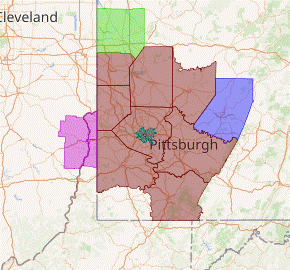Pittsburgh metro population ranking

“Southwestern Pennsylvania” redirects here. For the town in Westmoreland County, see Southwest, Pennsylvania.
Coordinates: 40°26′15″N 79°59′42″W | |
Country | |
State | Pennsylvania |
Largest city | Pittsburgh |
Population | |
• Total | 2,457,000 |
• Rank | |
GDP | |
• MSA | $153.3 billion (2022) |
Time zone | UTC−05:00 (Eastern Standard Time) |
• Summer (DST) | UTC−04:00 (Eastern Daylight Time) |
Pittsburgh is a city in Pennsylvania’s Allegheny County. Pittsburgh will have 293,501 residents by 2024. It serves as Allegheny County’s county seat as well. Pittsburgh’s population decreased by -3.06% from the most recent census, which recorded 302,777 people in 2020, and the city is currently falling at a pace of -0.77% annually.
Pittsburgh has an average household income of $80,248 and a 19.73% poverty rate. In recent years, the median property value has been – and the median monthly rental prices have been -. In Pittsburgh, the average age is 33.7 years, with 33.1 years for men and 34.6 years for women.
Pittsburgh is the second-biggest city in Pennsylvania and the center of the largest Ohio Valley and Appalachia metropolitan combined statistical area. Known as the Steel City for its 300 steel-based companies and the City of Bridges for a world-record 446 bridges, Pittsburgh has earned the title of the “most livable city” by Forbes and The Economist and a reputation for its environmental building design.
This may sound contradictory until you understand that other cities like Houston, Phoenix, and San Diego are continuously annexing their suburbs and increasing their land areas, whereas Pittsburgh’s city limits have remained almost intact from a century ago. Pittsburgh’s city limits were last increased in 1907.
Pittsburgh’s population would increase from about 300,000 to over a million if its city limits expanded to about the same area as any other city in the top 10, making it the ninth largest city in the US—a significant leap from 56.
It means that although Pittsburgh looks to be getting smaller on paper, it is expanding considerably as more people relocate to the suburbs. There are currently 5,540 people living in the city per square mile (2,140 per square kilometer). 1.733 million people are living in the urban area, 2.36 million in the metro area, and an estimated 2.62 million people living in the Combined Statistical Region (CSA) as of 2013.

Image: Wikipedia
Population and Diversity in Pittsburgh
According to the 2010 Census, Pittsburgh saw an 8.6% loss in population. On paper, the city has been decreasing since the 1960s and hasn’t expanded by more than 1% since 1930; however, this is partially because of the city’s rigid borders.
In Pittsburgh, German (19.7%), Irish (15.8%), Italian (11.8%), Polish (8.4%), and English (4.6) are the most common white heritage categories. 22% of people in the metro area are German, 21% are Irish, and 12% are Italian. It also suggests that Pittsburgh is home to one of the biggest Italian communities in the country. At over 200,000, it also has the largest Croatian community and the fifth-largest Ukrainian population in the US.
Pittsburgh Population Growth
Pittsburgh, a city best known for its steel industry, has begun to diversify its economy and move away from its reliance on manufacturing. This might be the chance it needs to escape the population loss of the last sixty years. It appears that Pittsburgh might be the country’s most recent boomtown after many decades.
Pittsburgh has been called the “comeback city” by Forbes in 2012 because the city has actually started to reverse its population decrease. According to Forbes, Allegheny County reversed its slide from 2005—when the IRS reported that the county had lost 1,000 taxpayers—to 2009—when more people had migrated into the whole country than left.
It indicates that natural decline and out-migration may be coming to an end, and that Pittsburgh’s population may soon be growing younger. Its median age decreased from 35.5 to 33.2 between 2000 and 2010.
As the population of Pittsburgh has decreased by about 3,000 as of 2017, it is still too early to anticipate the city’s population by the time of the next census in 2020.
Pittsburgh Demographics
Based on the latest American Community Survey (ACS), Pittsburgh’s ethnic population was:
- White: 65.42%
- Black or African American: 22.89%
- Asian: 5.58%
- Two or more races: 4.83%
- Other race: 1.05%
- Native American: 0.18%
- Native Hawaiian or Pacific Islander: 0.04%
Pittsburgh Median Age
- 33.7 Total
- 33.1 Male
- 34.6 Female
Pittsburgh Adults
Pittsburgh has 258,529 adults, 45,395 of whom are seniors.
Pittsburgh Age Dependency
- 42.3 Age Dependency Ratio
- 21.3 Old Age Dependency Ratio
- 21 Child Dependency Ratio

Image: Wikipedia
Pittsburgh Sex Ratio
Female | 154,839 | 51.07% |
Male | 148,368 | 48.93% |











Pingback: Biographies Mozart Society of America - USA NEWS PRINT